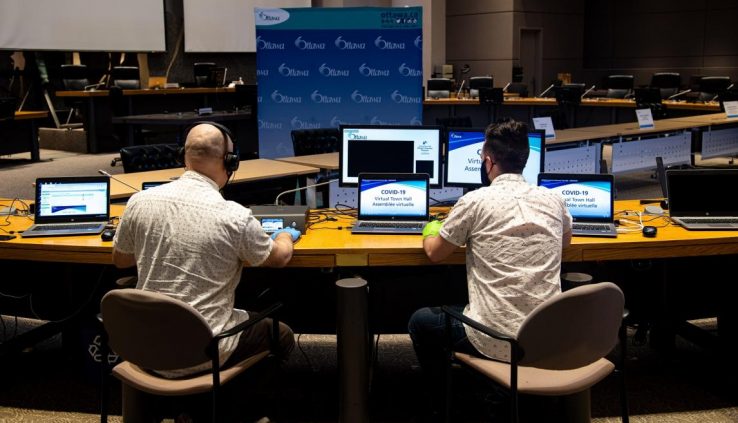A look Behind the Curtain: Meet the Duo that’s Mastering the Art of the Live Stream to Keep the Public in the Know About COVID-19
By Adam Noyes
The Covid-19 pandemic has called for a great influx of live streaming, but one of the most pressing causes is to keep the public informed. Information needs to spread quickly, and be packaged correctly so the audience listens. The Epiphan Pearl line of switchers, is a great tool to do this.
Check out some highlights from this article from Ottawa.ca to learn how Pearl Mini is being used for spreading information on Covid-19

Chris, what has it been like to take the City’s media availabilities and briefings virtual?
Chris: It all happened really quickly. We started looking at Zoom as an option on Tuesday March 31, and our first live-streamed event was the following Monday.
I used to work for Ottawa Public Health, so I understood how important it was to get this information to the public. We also wanted to make sure the media could be our ally in that effort, while not putting them at risk.
What goes into live streaming an event?
Chris: First, we had to find a space that would work for us. Depending on the type of event, we use anywhere between 4 and 7 laptops and monitors at once, so we need a lot of room to spread out and set everything up.
Council Chambers at Ottawa City Hall offers that space, and it also has the best internet connectivity, so that’s where we run these events.
So even though the participants aren’t in the room, information is still flowing through the heart of decision-making at the City. That seems fitting.
Chris: The symbolism is on point, for sure! City Hall is really quiet these days – as it should be – but it does feel right to be broadcasting these events out of Council Chambers.
How do you make them happen, from a technical standpoint?
Phil: It really is like running a mini TV broadcasting operation. The objective here is to make sure these events are accessible to as many people as possible.
Technical briefings and town hall meetings are a little more complicated than a media availability or a public health update. It can take up to six laptops to live stream those events. In a typical setup, one laptop runs the Zoom meeting, and another two run the English and French and sign language interpreters. We use a fourth laptop to monitor the two YouTube streams and to communicate with the Media Relations team. If presentations and graphics are involved, we add two more laptops.
We also work with Rogers Communications during some town halls and media availabilities. We tap into their feed, or they tap into ours, depending on who’s leading that event.

We feed each laptop into an encoder called Pearl-2, which takes the input from the laptops and lets us customize how the images from each are displayed on-screen for people watching on YouTube.
How often do these happen now?
Phil: There’s a media availability after each City Council meeting, and there are typically two COVID-19 media availabilities per week. We also assist with Ottawa Public Health updates, technical briefings and virtual Town Halls when needed. So far, we’ve broadcasted more than 25 press conferences, briefings, updates and virtual Town Hall meetings.
The good news is the media are participating and residents are tuning in. It shows us this new strategy is working and making a difference in the way the city communicates.
It sounds like you’ve been busy! Have there been any mishaps along the way?
Chris: There were some challenges at the beginning as people got used to using Zoom. It got better as presenters got into the habit of muting when they’re not speaking, limiting background noise, that sort of thing. It was a learning process for everyone involved. We’ve come a long way in a really short period of time, and we’ve got a good rhythm going now.

